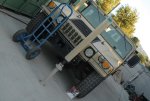tim292stro
Well-known member
- 2,117
- 40
- 48
- Location
- S.F. Bay Area/California
That's the idea, and with time alignment and fixed/measured distance I can do real-time radio direction finding.LOL wow, at that point I would rather have some kind of replica if there was one. I bet if I called to place an order they would be like "are you part of the military?". I can't believe you want four of them dang! I would be able to get into pretty much any frequency at that point.
A replica can be done with 4" pvc pipe painted tan...
It has to do with wave lengths and antenna distance. If you put two antennas within the incorrect wave length the two antennas will cancel out., the further apart they are, the wider the dispersion....As for connecting the whips together for a dual whip antenna, it will not work as well according to my local HAM radio guys. Now all this is according to the head radio geek they had on staff, but he threw out some jargon that backed up his case...
...What he was telling me, is that unless it is just for looks, you're fine, but in order to make it a functioning dual whip, you need to keep the 2 whips separated 9' apart which is equal to a quarter wave and the cable connection would have to have some sort of electrical coupler. I forgot what he was saying, because the dazed me with his radio voodoo sorcery for a bit... ...he was telling me that simply connecting them together with a radio shack T...
I will tell you that if you are SERIOUS about buying one of those at the rough price I "ball-parked", then talk to them. They do sell to the public (they have sold to colleges, that was my first clue), and they have a full datasheet available if you are willing to go into an NDA, and upon purchase be prepared to sign an End-Use Certificate. That's all I believe I am allowed to say, because I'm under that NDA. Realize that this antenna is current, and part of systems that DoD probably doen't want compromised - part of my delay in purchase is working to ensure I can develop a physical security program to prevent these from being stolen or captured here in CONUS.Hi Tim292stro, are you referring to an RFR-105 antenna on which the datasheet is based? Interesting antenna. Very wideband as you said. I'd like to get my hands on one for some testing.
It could work fine for a wideband scanner or even ham transceiver. Looks 'right' on an MV too. I was looking for a spec sheet for (ham use) that would give gain figures and only found one reference stating 0 dBiL (db isotropic, linear polarization). That converts to -2.1 dBd (dipole) if I did the numbers right...

Last edited:



